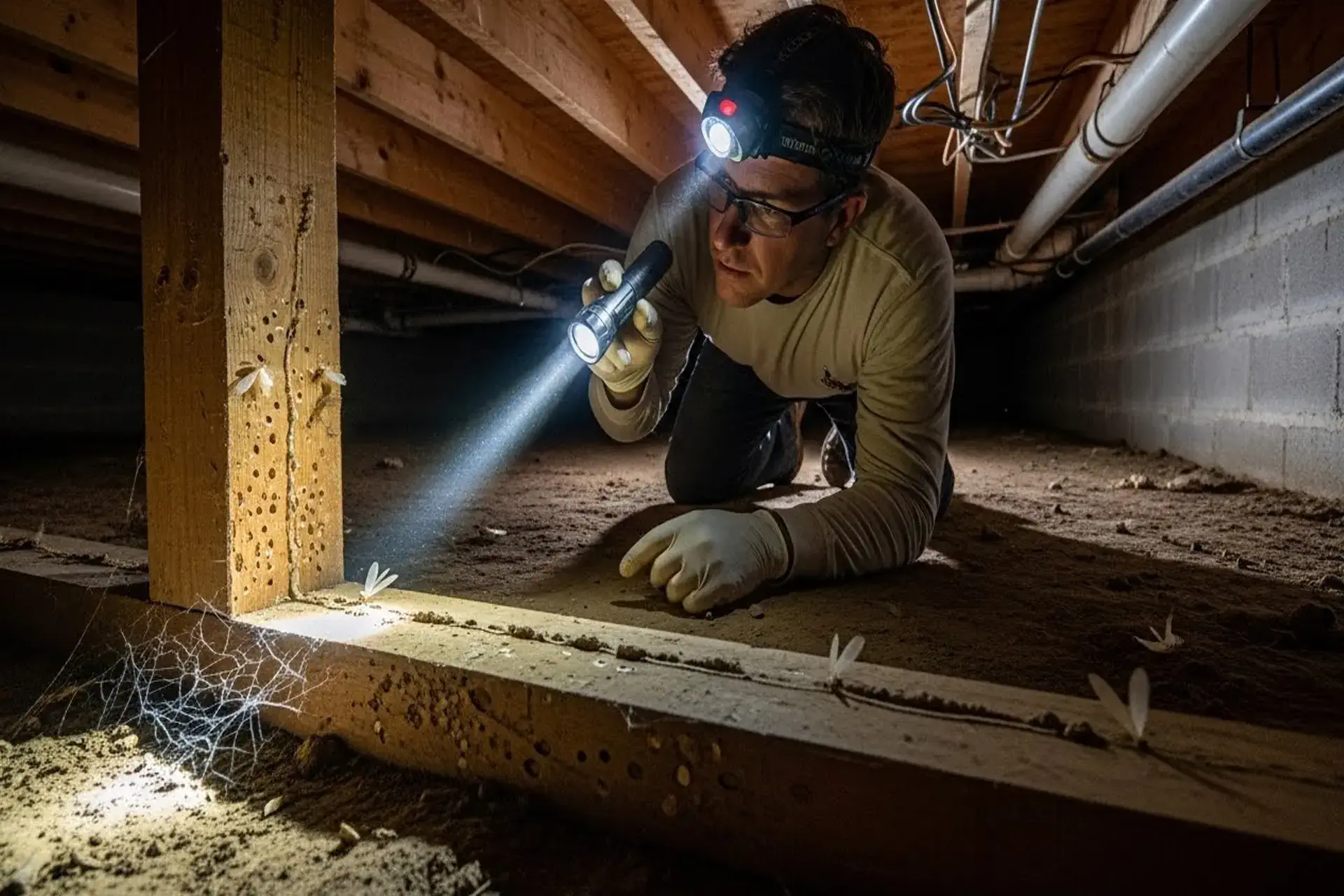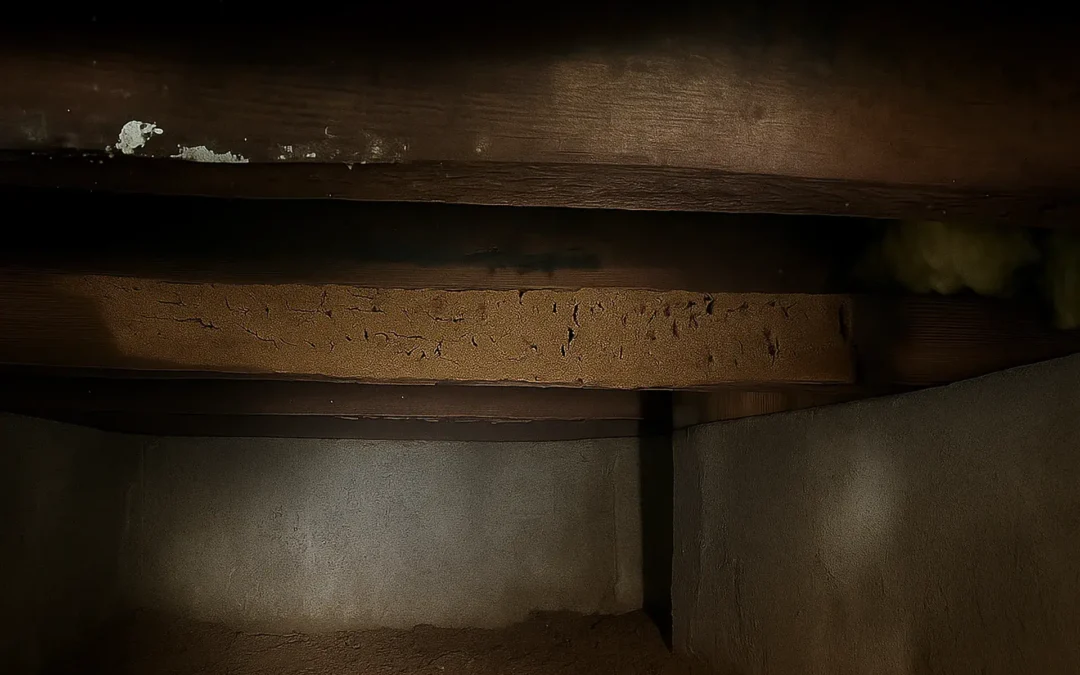If you’ve noticed what looks like termite damage in your crawl space, or anywhere in your home, it could be a serious problem. Termites might be small, but when working together, a colony can eat through a pound of wood every few days. That’s not something you want to leave on the back burner.
At Zavza Seal, we understand how quickly termites can cause structural damage to New York homes. Once they get into your crawl space, they don’t stop until the wood is gone. Their damage weakens critical beams, sill plates, and joists before you even realize what’s happening.
If you’re in Long Island, Brooklyn, Queens, or The Bronx and have seen signs of termites, or just aren’t sure what you’re looking at, contact us right away. We’ll inspect your crawl space, identify the problem, and recommend lasting repair and prevention solutions.
Contact Zavza Seal Today for a Free Crawl Space Inspection and Expert Termite Damage Assessment
Termite Damage in Crawl Spaces
Did you know that one of the main causes of termite damage is wood and debris left in crawl spaces? Termite damage occurs when colonies of wood-eating insects feed on the cellulose inside structural wood members, hollowing them from the inside out. Over time, this hidden destruction weakens joists, beams, sill plates, and subfloor supports, leading to sagging floors and serious structural instability.
A crawl space is the narrow, unfinished area beneath many New York homes, especially those built on pier-and-beam or wood-frame foundations. These spaces often have exposed wood, direct soil contact, and limited airflow, creating the perfect breeding ground for termites. When combined with New York’s seasonal humidity and coastal moisture, conditions become ideal for colonies to expand rapidly.
Experts estimate that a Formosan termite colony can inflict major structural damage in under six months when conditions are favorable and the climate is ideal. In New York, termite damage is typically not covered by homeowners insurance, leaving property owners responsible for costly repairs.
For these reasons, early detection and professional inspection of crawl spaces are very important if you want to protect your home.
Don’t Worry! Our Opinion is Always Free! Contact Zavza Seal Now for a Free Assessment Now!
Benefits of Professional Termite Damage Repair
When termites attack the structural framing of a New York home, fast and professional repair is the only way to restore safety and stop further damage. DIY attempts rarely address hidden infestations or deeper structural issues. Professional repair ensures that the framing is reinforced, the moisture problem is solved, and the crawl space becomes a protected, termite-resistant environment.
Key Benefits
- Restored Structural Integrity
- Improved Safety and Load Support
- Elimination of Hidden Termite Pathways
- Long-Term Protection Against Future Infestations
- Optimized Crawl Space Moisture Control
- Increased Energy Efficiency
- Boosted Property Value
- Code-Compliant Repair and Reinforcement
- Comprehensive Detection of All Damage
- Better Resale Confidence for Buyers
Contact Zavza Seal Today for Professional Termite Damage Repair and Crawl Space Protection!
Measurements: How to Identify & Quantify Termite Damage in Crawl Spaces
Identifying termite damage in a crawl space requires more than a quick visual check. Termites eat wood from the inside out, leaving behind warning signs that homeowners in New York often miss until sagging floors or structural shifts begin. A proper crawl space inspection focuses on measurable indicators, the clues that tell you how advanced the infestation and structural damage may be.

How to Inspect a Crawl Space for Termite Activity
During an inspection, you or a professional should look for the following physical signs:
- Hollow-Sounding Wood: Tap beams, joists, and sill plates; a hollow or papery sound suggests internal feeding.
- Sagging or Uneven Floors: Termite-weakened joists often cause floors above the crawl space to dip.
- Mud Tubes: Pencil-width tunnels on foundation walls or piers indicate active subterranean termite movement.
- Frass (Termite Droppings): Piles of fine, sand-like pellets near wood members signal drywood termite activity.
- Discarded Wings: Swarmers shed wings around entry points when forming new colonies.
- Soft, Blistered, or Crumbling Wood: Visible deformation means the termite colony has already progressed.
Quantifying Termite Risk in New York Regions
Some areas of New York naturally carry a higher risk due to climate and age of housing:
- Older homes in Brooklyn, Queens, and The Bronx tend to have original framing, unsealed crawl spaces, and past moisture problems.
- Long Island’s coastal humidity accelerates wood moisture retention, increasing termite attraction.
- Homes with direct soil-to-wood contact face the highest risk of rapid colony expansion.
Key Measurements & Thresholds to Know
Professionals use numerical benchmarks to determine severity:
- Sagging Floors Greater Than ½-1 Inch: Indicates structural weakening of joists or sill plates.
- Moisture Levels Above 60 Percent in the Crawl Space: Creates ideal conditions for termite survival and expansion.
- Wood Moisture Content Above 20 Percent: High likelihood of active termite or fungal activity.
- Wood-To-Soil Clearance Less Than 6 Inches: A major risk factor; recommended minimum is a 6-inch gap.
- Visible Penetration Depth: If termites have eaten ¼ inch or more into beams or joists, load capacity may already be compromised.
Why These Measurements Matter
In New York homes, especially in humid, coastal, or older neighborhoods termite activity is rarely isolated. Once they reach the crawl space framing, damage accelerates quickly. Quantifying the extent tells you whether immediate repair, reinforcement, encapsulation, or moisture control is necessary.
Book Zavza Seal’s Crawl Space Assessment and Termite Damage Quote Today!
Structured Reasoning: Why Termite Damage Happens in New York Crawl Spaces & What to Do (H2)
Termite damage follows a predictable pattern driven by moisture, wood accessibility, and the hidden nature of crawl spaces. Understanding why termites thrive in these environments helps homeowners see the urgency of addressing the problem head-on.
Why Crawl Spaces Become Termite Hotspots
Here’s the reasoning chain behind most New York infestations:
- Moisture builds up in crawl spaces due to humidity, poor grading, plumbing leaks, or lack of encapsulation.
- Moisture + exposed wood + soil contact creates the perfect conditions for subterranean termites to feed and nest.
- Older framing common in Long Island, Queens, Brooklyn, and The Bronx often has weathered, untreated wood that absorbs moisture, making it easier for termites to penetrate.
- Limited ventilation and hidden entry points allow termites to move undetected through foundation cracks, vents, piers, and support posts.
- Termites eat wood from the inside out, meaning damage stays hidden until beams are severely compromised.
- Structural warning signs appear slowly, such as sagging floors, bouncing joists, cracked drywall, sticking doors, or rim joist deterioration.
- Left untreated, compromised framing reduces structural integrity, increases safety risks, and lowers resale value.
What New York Homeowners Should Do
Handling termite-related crawl space damage requires a coordinated set of steps:
Step 1: Schedule a Full Crawl Space Inspection
A combined structural + pest inspection is essential to determine:
- Whether termites are active
- The extent of wood damage
- Moisture sources feeding the colony
Step 2: Repair or Replace Damaged Wood
This may include:
- Joist repair or sistering
- Beam and sill plate replacement
- Reinforcing rim joists and subfloor components
All repairs must follow local building code and be performed under licensed oversight for safety and load-bearing accuracy.
Step 3: Crawl Space Remediation
Once repairs begin, the crawl space must be corrected so termites cannot return:
- Full or partial encapsulation
- Heavy-duty vapor barrier installation
- Drainage improvements
- Sealing vents, gaps, and foundation penetrations
- Installing a dehumidifier to maintain <60% humidity
Step 4: Termite Prevention Treatments
Long-term solutions may include:
- Borate wood treatment
- Soil treatments and termiticide barriers
- Physical shields or block-out barriers
- Re-establishing proper clearance between wood and soil
Why This Structured Approach Works
This layered plan removes the conditions that caused the infestation, restores the structural integrity of the home, and ensures termites cannot return. Without this sequence — inspect → repair → remediate → prevent, the problem will always resurface.
Contact Zavza Seal Now for a Comprehensive Crawl Space Repair and Termite Prevention Plan for Your New York Home
Prevention: Long-Term Strategies for New York Homes
Preventing termite damage in New York requires eliminating moisture, removing food sources, and ensuring your crawl space is properly protected year-round. With coastal humidity, older framing, and shifting soil conditions, homes in Long Island, Brooklyn, Queens, and The Bronx need ongoing prevention to stay termite resistant. These long-term strategies help reduce the risk of infestation and protect structural framing over time.
Key Prevention Best Practices
- Ensure Wood-To-Soil Contact Is Eliminated: Maintain a minimum 6-inch gap between soil and wooden structural members.
- Manage Moisture in the Crawl Space: Fix plumbing leaks, install gutters and downspouts, encapsulate the crawl space, and use a dehumidifier.
- Remove Nearby Wood Debris: Keep firewood, tree stumps, and mulch away from the foundation.
- Seal Cracks and Openings: Close gaps in foundation walls, utility penetrations, and crawl space vents.
- Schedule Annual Termite and Structural Inspections: Combine pest control reviews with annual structural evaluations to prevent hidden issues.
Ask Zavza Seal for our termite-resistant crawl space package and annual maintenance plan.
Why Choose Zavza Seal for Crawl Space Termite Repair & Prevention
New York homes face unique structural and environmental challenges, especially in regions like Long Island, Brooklyn, Queens, and The Bronx where coastal humidity and older housing stock increase termite activity. Zavza Seal specializes in crawl space environments common to these neighborhoods and understands both the structural and environmental conditions that contribute to termite damage.
What Sets Us Apart
- Specialized Expertise in New York Crawl Spaces
- Structural Repair Backed by Licensed Construction Pros
- Moisture and Humidity Control That Reduces Termite Risk
- Integrated Solutions Combining Repair and Prevention
- Local Knowledge of Soil Conditions and Urban Building Styles
- Experience Across Long Island, Brooklyn, Queens, and The Bronx
Schedule Your Free Structural and Termite Risk Inspection With Zavza Seal Today
Termite Damage in Crawl Spaces: Final Thoughts
Termite damage in crawl spaces is a serious threat for New York homes. With the right approach, including early detection, professional repair, moisture control, and long-term prevention, homeowners can protect their property, maintain structural safety, and preserve resale value. You do not have to wait for sagging floors or visible beam damage to take action.
Schedule Your Free Crawl Space Termite Damage Assessment With Zavza Seal Today
Frequently Asked Questions About Termites in Crawl Spaces:
What Is the Difference Between Termite Damage and Wood Rot?
Termite damage happens when insects eat the cellulose inside wood, leaving hollowed or weakened areas. Wood rot occurs when moisture causes fungal decay. Both compromise structural framing but require different treatment and repair methods.
Can I Repair Termite Damage Myself?
DIY termite repair is not recommended. Damage is usually hidden inside beams and joists, and improper fixes leave structural weaknesses. A professional inspection ensures the infestation is eliminated and the structure is safely restored.
How Often Should I Inspect My Crawl Space for Termites in New York?
Most New York homes should be inspected at least once per year. Homes in humid or coastal areas such as Long Island or Queens benefit from biannual inspections to detect early signs of activity.
Does Homeowners Insurance Cover Termite Damage?
Most insurance policies in New York do not cover termite damage because it is considered preventable. Homeowners are responsible for inspections, repairs, and long-term prevention measures.
How Quickly Can Termite Damage Get Worse in a Crawl Space?
Termite damage can worsen in a matter of months. In ideal conditions, colonies can cause significant structural harm in less than a year by hollowing beams and joists from the inside out.
What Are the First Signs of Termites in a Crawl Space?
Common early signs include mud tubes, hollow-sounding wood, frass, discarded wings, blistered wood, soft spots, and sagging floors. These indicate active or recent termite activity.
Are Termites Common in New York Crawl Spaces?
Yes. New York’s humidity, soil conditions, and older wooden framing make crawl spaces common hotspots for subterranean termite activity. Long Island, Brooklyn, Queens, and The Bronx are especially vulnerable.
How Do I Prevent Termites From Entering My Crawl Space?
Prevention includes eliminating wood-to-soil contact, reducing moisture, sealing cracks, adding vapor barriers, improving drainage, and scheduling annual inspections. Encapsulation and dehumidifiers can greatly reduce risk.
Do Termites Come Back After Treatment?
Termites can return if moisture or soil access remains. Long-term success requires repairing damaged wood, correcting crawl space humidity, and maintaining protective barriers or treatments.
When Should I Call a Professional for Termite Damage?
Call a professional immediately if you notice mud tubes, soft wood, sagging floors, frass, discarded wings, or any unexplained structural movement. Early action prevents deeper and more costly damage.








